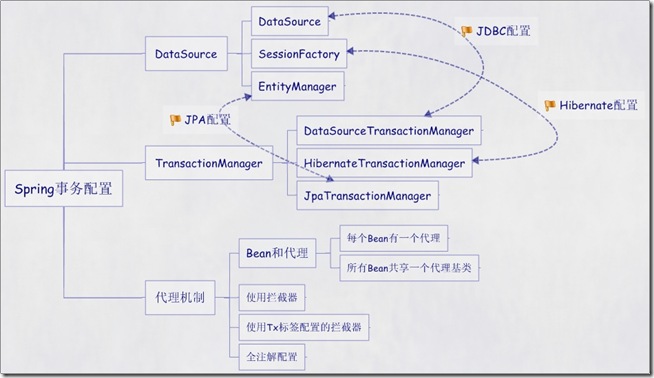Spring对事务的解决办法分为2种:编程式实现事务;AOP配置声明式解决方案。
编程式事务是不推荐的,只有在为了深入理解Spring事务管理时才需要学习编程式事务使用。
Spring声明式事务,让我们从复杂的事务处理中得到解脱。使得我们再也无需要去处理获得连接、关闭连接、事务提交和回滚等这些操作。再也无需要我们在与事务相关的方法中处理大量的try…catch…finally代码。
我们在使用Spring声明式事务时,有一个非常重要的概念就是事务属性。事务属性通常由事务的传播行为,事务的隔离级别,事务的超时值和事务只读标志组成。我们在进行事务划分时,需要进行事务定义,也就是配置事务的属性。
http://www.blogjava.net/robbie/archive/2009/04/05/264003.html
在Spring的配置文件中,关于事务的配置总体上由三个组成部分,分别是DataSource、TransactionManager和代理机制这三部分,无论哪种配置方式,一般变化的只是代理机制这部分。
DataSource、TransactionManager这两部分只是会根据数据访问方式有所变化,比如使用Hibernate进行数据访问时,DataSource实际为SessionFactory,TransactionManager的实现为HibernateTransactionManager。
根据代理机制的不同,总结了五种Spring事务的配置方式,具体如下图:(图片更正:JTA配置,JtaTransactionManager)
第一种方式:每个Bean都有一个代理
< beans xmlns ="http://www.springframework.org/schema/beans"
xmlns:xsi ="http://www.w3.org/2001/XMLSchema-instance"
xmlns:context ="http://www.springframework.org/schema/context"
xmlns:aop ="http://www.springframework.org/schema/aop"
xsi:schemaLocation ="http://www.springframework.org/schema/beans
http://www.springframework.org/schema/beans/spring-beans-2.5.xsd
http://www.springframework.org/schema/context
http://www.springframework.org/schema/context/spring-context-2.5.xsd
http://www.springframework.org/schema/aop http://www.springframework.org/schema/aop/spring-aop-2.5.xsd" >
< bean id ="sessionFactory"
class ="org.springframework.orm.hibernate3.LocalSessionFactoryBean" >
< property name ="configLocation" value ="classpath:hibernate.cfg.xml" />
< property name ="configurationClass" value ="org.hibernate.cfg.AnnotationConfiguration" />
</ bean >
<!-- 定义事务管理器(声明式的事务) -->
< bean id ="transactionManager"
class ="org.springframework.orm.hibernate3.HibernateTransactionManager" >
< property name ="sessionFactory" ref ="sessionFactory" />
</ bean >
<!-- 配置DAO -->
< bean id ="userDaoTarget" class ="com.bluesky.spring.dao.UserDaoImpl" >
< property name ="sessionFactory" ref ="sessionFactory" />
</ bean >
< bean id ="userDao"
class ="org.springframework.transaction.interceptor.TransactionProxyFactoryBean" >
<!-- 配置事务管理器 -->
< property name ="transactionManager" ref ="transactionManager" />
< property name ="target" ref ="userDaoTarget" />
< property name ="proxyInterfaces" value ="com.bluesky.spring.dao.GeneratorDao" />
<!-- 配置事务属性 -->
< property name ="transactionAttributes" >
< props >
< prop key ="*" > PROPAGATION_REQUIRED </ prop >
</ props >
</ property >
</ bean >
</ beans >
第二种方式:所有Bean共享一个代理基类
< beans xmlns ="http://www.springframework.org/schema/beans"
xmlns:xsi ="http://www.w3.org/2001/XMLSchema-instance"
xmlns:context ="http://www.springframework.org/schema/context"
xmlns:aop ="http://www.springframework.org/schema/aop"
xsi:schemaLocation ="http://www.springframework.org/schema/beans
http://www.springframework.org/schema/beans/spring-beans-2.5.xsd
http://www.springframework.org/schema/context
http://www.springframework.org/schema/context/spring-context-2.5.xsd
http://www.springframework.org/schema/aop http://www.springframework.org/schema/aop/spring-aop-2.5.xsd" >
< bean id ="sessionFactory"
class ="org.springframework.orm.hibernate3.LocalSessionFactoryBean" >
< property name ="configLocation" value ="classpath:hibernate.cfg.xml" />
< property name ="configurationClass" value ="org.hibernate.cfg.AnnotationConfiguration" />
</ bean >
<!-- 定义事务管理器(声明式的事务) -->
< bean id ="transactionManager"
class ="org.springframework.orm.hibernate3.HibernateTransactionManager" >
< property name ="sessionFactory" ref ="sessionFactory" />
</ bean >
< bean id ="transactionBase"
class ="org.springframework.transaction.interceptor.TransactionProxyFactoryBean"
lazy-init ="true" abstract ="true" >
<!-- 配置事务管理器 -->
< property name ="transactionManager" ref ="transactionManager" />
<!-- 配置事务属性 -->
< property name ="transactionAttributes" >
< props >
< prop key ="*" > PROPAGATION_REQUIRED </ prop >
</ props >
</ property >
</ bean >
<!-- 配置DAO -->
< bean id ="userDaoTarget" class ="com.bluesky.spring.dao.UserDaoImpl" >
< property name ="sessionFactory" ref ="sessionFactory" />
</ bean >
< bean id ="userDao" parent ="transactionBase" >
< property name ="target" ref ="userDaoTarget" />
</ bean >
</ beans >
第三种方式:使用拦截器
< beans xmlns ="http://www.springframework.org/schema/beans"
xmlns:xsi ="http://www.w3.org/2001/XMLSchema-instance"
xmlns:context ="http://www.springframework.org/schema/context"
xmlns:aop ="http://www.springframework.org/schema/aop"
xsi:schemaLocation ="http://www.springframework.org/schema/beans
http://www.springframework.org/schema/beans/spring-beans-2.5.xsd
http://www.springframework.org/schema/context
http://www.springframework.org/schema/context/spring-context-2.5.xsd
http://www.springframework.org/schema/aop http://www.springframework.org/schema/aop/spring-aop-2.5.xsd" >
< bean id ="sessionFactory"
class ="org.springframework.orm.hibernate3.LocalSessionFactoryBean" >
< property name ="configLocation" value ="classpath:hibernate.cfg.xml" />
< property name ="configurationClass" value ="org.hibernate.cfg.AnnotationConfiguration" />
</ bean >
<!-- 定义事务管理器(声明式的事务) -->
< bean id ="transactionManager"
class ="org.springframework.orm.hibernate3.HibernateTransactionManager" >
< property name ="sessionFactory" ref ="sessionFactory" />
</ bean >
< bean id ="transactionInterceptor"
class ="org.springframework.transaction.interceptor.TransactionInterceptor" >
< property name ="transactionManager" ref ="transactionManager" />
<!-- 配置事务属性 -->
< property name ="transactionAttributes" >
< props >
< prop key ="*" > PROPAGATION_REQUIRED </ prop >
</ props >
</ property >
</ bean >
< bean class ="org.springframework.aop.framework.autoproxy.BeanNameAutoProxyCreator" >
< property name ="beanNames" >
< list >
< value > *Dao </ value >
</ list >
</ property >
< property name ="interceptorNames" >
< list >
< value > transactionInterceptor </ value >
</ list >
</ property >
</ bean >
<!-- 配置DAO -->
< bean id ="userDao" class ="com.bluesky.spring.dao.UserDaoImpl" >
< property name ="sessionFactory" ref ="sessionFactory" />
</ bean >
</ beans >
第四种方式:使用tx标签配置的拦截器
< beans xmlns ="http://www.springframework.org/schema/beans"
xmlns:xsi ="http://www.w3.org/2001/XMLSchema-instance"
xmlns:context ="http://www.springframework.org/schema/context"
xmlns:aop ="http://www.springframework.org/schema/aop"
xmlns:tx ="http://www.springframework.org/schema/tx"
xsi:schemaLocation ="http://www.springframework.org/schema/beans
http://www.springframework.org/schema/beans/spring-beans-2.5.xsd
http://www.springframework.org/schema/context
http://www.springframework.org/schema/context/spring-context-2.5.xsd
http://www.springframework.org/schema/aop http://www.springframework.org/schema/aop/spring-aop-2.5.xsd
http://www.springframework.org/schema/tx http://www.springframework.org/schema/tx/spring-tx-2.5.xsd" >
< context:annotation-config />
< context:component-scan base-package ="com.bluesky" />
< bean id ="sessionFactory"
class ="org.springframework.orm.hibernate3.LocalSessionFactoryBean" >
< property name ="configLocation" value ="classpath:hibernate.cfg.xml" />
< property name ="configurationClass" value ="org.hibernate.cfg.AnnotationConfiguration" />
</ bean >
<!-- 定义事务管理器(声明式的事务) -->
< bean id ="transactionManager"
class ="org.springframework.orm.hibernate3.HibernateTransactionManager" >
< property name ="sessionFactory" ref ="sessionFactory" />
</ bean >
< tx:advice id ="txAdvice" transaction-manager ="transactionManager" >
< tx:attributes >
< tx:method name ="*" propagation ="REQUIRED" />
</ tx:attributes >
</ tx:advice >
< aop:config >
< aop:pointcut id ="interceptorPointCuts"
expression ="execution(* com.bluesky.spring.dao.*.*(..))" />
< aop:advisor advice-ref ="txAdvice"
pointcut-ref ="interceptorPointCuts" />
</ aop:config >
</ beans >
*****************************************************************************************************
XML形式的事务配置<tx:method >的属性详解
|
属性
|
类型
|
默认值
|
说明
|
| propagation | Propagation枚举 | REQUIRED | 事务传播属性 |
| isolation | isolation枚举 | DEFAULT(所用数据库默认级别) | 事务隔离级别 |
| readOnly | boolean | false | 是否才用优化的只读事务 |
| timeout | int | -1 | 超时(秒) |
| rollbackFor | Class[] | {} | 需要回滚的异常类 |
| rollbackForClassName | String[] | {} | 需要回滚的异常类名 |
| noRollbackFor | Class[] | {} | 不需要回滚的异常类 |
| noRollbackForClassName | String[] | {} | 不需要回滚的异常类名 |
*readOnly
事务属性中的readOnly标志表示对应的事务应该被最优化为只读事务。如果值为true就会告诉Spring我这个方法里面没有insert或者update,你只需要提供只读的数据库Connection就行了,这种 执行效率会比read-write的Connection高,所以这是一个最优化提示 。在一些情况下,一些事务策略能够起到显著的最优化效果,例如在使用Object/Relational映射工具(如:Hibernate或TopLink)时避免dirty checking(试图“刷新”)。
*timeout
在属性中还有定义“timeout”值的选项,指定事务超时为几秒。一般不会使用这个属性。在JTA中,这将被简单地传递到J2EE服务器的事务协调程序,并据此得到相应的解释。
*Isolation Level(事务隔离等级)的5个枚举值
为什么事务要有Isolation Level这个属性?先回顾下数据库事务的知识:
第一类丢失更新(lost update) :在完全未隔离事务的情况下,两个事物更新同一条数据资源,某一事物异常终止,回滚造成第一个完成的更新也同时丢失。
第二类丢失更新(second lost updates) :是不可重复读的特殊情况,如果两个事务都读取同一行,然后两个都进行写操作,并提交,第一个事务所做的改变就会丢失。
脏读(dirty read) :如果第二个事务查询到第一个事务还未提交的更新数据,形成脏读。因为第一个事务你还不知道是否提交,所以数据不一定是正确的。
虚读(phantom read) :一个事务执行两次查询,第二次结果集包含第一次中没有或者某些行已被删除,造成两次结果不一致,只是另一个事务在这两次查询中间插入或者删除了数据造成的。
不可重复读(unrepeated read) :一个事务两次读取同一行数据,结果得到不同状态结果,如中间正好另一个事务更新了该数据,两次结果相异,不可信任。
具体关于事务机制可以看我以前的博客: http://zhou137520.iteye.com/admin/blogs/1638574
当遇到以上这些情况时我们可以设置isolation下面这些枚举值:
DEFAULT :采用数据库默认隔离级别
SERIALIZABLE :最严格的级别,事务串行执行,资源消耗最大;
REPEATABLE_READ :保证了一个事务不会修改已经由另一个事务读取但未提交(回滚)的数据。避免了“脏读取”和“不可重复读取”的情况,但是带来了更多的性能损失。
READ_COMMITTED :大多数主流数据库的默认事务等级,保证了一个事务不会读到另一个并行事务已修改但未提交的数据,避免了“脏读取”。该级别适用于大多数系统。
READ_UNCOMMITTED :保证了读取过程中不会读取到非法数据。隔离级别在于处理多事务的并发问题。
*关于propagation属性的7个传播行为
REQUIRED :指定当前方法必需在事务环境中运行,如果当前有事务环境就加入当前正在执行的事务环境,如果当前没有事务,就新建一个事务。这是默认值。
SUPPORTS :指定当前方法加入当前事务环境,如果当前没有事务,就以非事务方式执行。
MANDATORY :指定当前方法必须加入当前事务环境,如果当前没有事务,就抛出异常。
REQUIRES_NEW :指定当前方法总是会为自己发起一个新的事务,如果发现当前方法已运行在一个事务中,则原有事务被挂起,我自己创建一个属于自己的事务,直我自己这个方法commit结束,原先的事务才会恢复执行。
NOT_SUPPORTED :指定当前方法以非事务方式执行操作,如果当前存在事务,就把当前事务挂起,等我以非事务的状态运行完,再继续原来的事务。
NEVER :指定当前方法绝对不能在事务范围内执行,如果方法在某个事务范围内执行,容器就抛异常,只有没关联到事务,才正常执行。
NESTED :指定当前方法执行时,如果已经有一个事务存在,则运行在这个嵌套的事务中.如果当前环境没有运行的事务,就新建一个事务,并与父事务相互独立,这个事务拥有多个可以回滚的保证点。就是指我自己内部事务回滚不会对外部事务造成影响,只对DataSourceTransactionManager事务管理器起效。
***********************************************************************************************
第五种方式:全注解
< beans xmlns ="http://www.springframework.org/schema/beans"
xmlns:xsi ="http://www.w3.org/2001/XMLSchema-instance"
xmlns:context ="http://www.springframework.org/schema/context"
xmlns:aop ="http://www.springframework.org/schema/aop"
xmlns:tx ="http://www.springframework.org/schema/tx"
xsi:schemaLocation ="http://www.springframework.org/schema/beans
http://www.springframework.org/schema/beans/spring-beans-2.5.xsd
http://www.springframework.org/schema/context
http://www.springframework.org/schema/context/spring-context-2.5.xsd
http://www.springframework.org/schema/aop http://www.springframework.org/schema/aop/spring-aop-2.5.xsd
http://www.springframework.org/schema/tx http://www.springframework.org/schema/tx/spring-tx-2.5.xsd" >
< context:annotation-config />
< context:component-scan base-package ="com.bluesky" />
< tx:annotation-driven transaction-manager ="transactionManager" />
< bean id ="sessionFactory"
class ="org.springframework.orm.hibernate3.LocalSessionFactoryBean" >
< property name ="configLocation" value ="classpath:hibernate.cfg.xml" />
< property name ="configurationClass" value ="org.hibernate.cfg.AnnotationConfiguration" />
</ bean >
<!-- 定义事务管理器(声明式的事务) -->
< bean id ="transactionManager"
class ="org.springframework.orm.hibernate3.HibernateTransactionManager" >
< property name ="sessionFactory" ref ="sessionFactory" />
</ bean >
</ beans >
此时在DAO上需加上@Transactional注解,如下:
import java.util.List;
import org.hibernate.SessionFactory;
import org.springframework.beans.factory.annotation.Autowired;
import org.springframework.orm.hibernate3.support.HibernateDaoSupport;
import org.springframework.stereotype.Component;
import com.bluesky.spring.domain.User;
@Transactional
@Component( " userDao " )
public class UserDaoImpl extends HibernateDaoSupport implements UserDao {
public List < User > listUsers() {
return this .getSession().createQuery( " from User " ).list();
}

}
而@Transaction注解事务,如果一个项目模块太多,service方法太多导致每个方法都要手动去加注解,是不是很麻烦,也容易出错。如果一个项目结构清晰,分层明确,那么标签形式的配置将是最直观和方便的办法。
总之,能保证项目正常工作的事务配置就是最好的。
























 被折叠的 条评论
为什么被折叠?
被折叠的 条评论
为什么被折叠?








